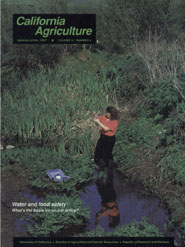


University of California
California Agriculture



|
|||
|
|||

Water and food safety: What's the basis for sound policy?
Cover:
Dayna Wilson, Cooperative Extension dairy program representative for Sonoma and Marin counties, tests water quality in Stemple Creek, part of the watershed that empties into Tomales Bay.
March-April 1997
Volume 51, Number 2 |
|||
|
University of California, 1301 S. 46th St., Bldg. 478 Richmond, CA
|